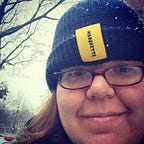“Books as Medicine,” An Online Exhibit on the Healing Power of Books
Tuesday was my first day as the new Digital Humanities Specialist working with the Digital Scholarship Lab, and to celebrate, I wanted to share with you a new example of a Digital Humanities project that embodies the way libraries and digital scholarship centers can work with students and teachers to create learning tools and experiences.
The Books as Medicine website is an online companion that complements a physical exhibit on WWI and bibliotherapy located at the University of Connecticut’s Homer D. Babbidge Library. The exhibit was created by history PhD candidate Mary-Margaret Mahoney, whose research and dissertation focus on the History of Books and Reading in 19th- and 20th-century America, and more specifically, bibliotherapy, the use of books as sources of healing.
The online exhibit, titled From Library War Service to Science: Bibliotherapy in World War I, presents resources and interactive elements to educate visitors on the little-known history of doctors and librarians collaborating in the treatment of mental health. Mahoney describes the role of the Library War Service in collecting and distributing books to soldiers, and the rationale behind such a wide-scale program, the belief that books provided the troops with comfort, education, training, and could even act as a form of therapy for those struggling with the mental toll of war and warfare. This might sound strange to us now, but in a time before penicillin was even discovered, when medical treatments were still based as much on folklore and hope as science, the idea of books as a source of healing was a powerful one.
Like most of you, I didn’t know that military hospitals often had librarians stationed within them and that they managed small collections (sometimes up to 3,500 books)to help with the recovery of the wounded. In fact, books were actually “prescribed” by doctors and librarians in the same way a patient might be prescribed a treatment for lice or instructed to have their bandages changed twice a day. At the exhibit, visitors can read a poem popular in the treatment of tuberculosis and share their conclusions on the efficacy of the medicine, or their own thoughts about how the poem might work to heal patients.
So what kind of books were prescribed? Mahoney shares some of the choices made by one particular librarian during her time in the Library War Service, and some of the guidelines that were followed. In general, it seems, a good rule of thumb was that the book had to engage the reader’s mind and prevent him from reflecting on his experiences — so, naturally, fiction and genres like adventure stories, westerns, and science-fiction were big hits. At the same time, some books were banned from being given to soldiers, especially ones that were considered too pacifist or ideologically controversial for the American soldier to read.
Even after the war ended, the practice of bibliotherapy persisted, as the librarians and doctors brought the treatment plan back with them to the home front and into civilian doctors’ offices. Mahoney invites visitors to the website to take a moment and make their own literary prescription by filling out a Google form with the title of a book appropriate for a person “going through a tough time” and why it makes “good medicine.”
I suggested (after a lot of thinking and a long time looking through my Goodreads bookshelves) Jasper Fforde’s The Eyre Affair. Why? It’s a rollicking adventure, and it’s funny to the point of almost being ridiculous. And what better cure for when you’re feeling down than a book that will make you laugh?
So, why share this particular piece of scholarship in the digital humanities?
Because it’s a great example of the connection between libraries and digital scholarship. It’s the kind of project that the Digital Scholarship Lab here at Marquette could easily assist a student or professor in creating. The text of each page is determined by Mahoney’s research, data curation, and the story she wants to tell. And the digital tools — hypothes.is, the web annotation application she used to allow visitors to comment on the poem, and the Google Form that allows users to submit their own prescriptions — are user-friendly for both web-content creators and web users.
(And also because I’ve long believed that there’s no better medicine than a good book and a hot cup of tea.)
